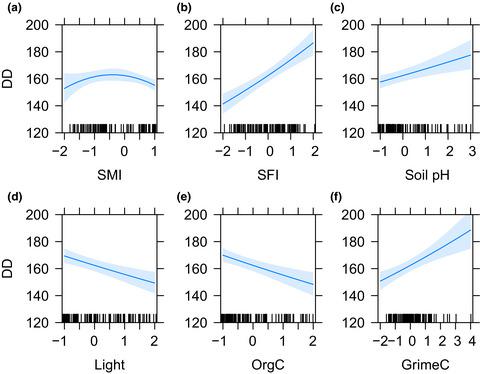当前位置:
X-MOL 学术
›
Ecol. Evol.
›
论文详情
Our official English website, www.x-mol.net, welcomes your
feedback! (Note: you will need to create a separate account there.)
Dark diversity reveals importance of biotic resources and competition for plant diversity across habitats.
Ecology and Evolution ( IF 2.3 ) Pub Date : 2020-06-04 , DOI: 10.1002/ece3.6351 Camilla Fløjgaard 1 , Jose W Valdez 1 , Lars Dalby 1 , Jesper Erenskjold Moeslund 1 , Kevin K Clausen 1 , Rasmus Ejrnæs 1 , Meelis Pärtel 2 , Ane Kirstine Brunbjerg 1
Ecology and Evolution ( IF 2.3 ) Pub Date : 2020-06-04 , DOI: 10.1002/ece3.6351 Camilla Fløjgaard 1 , Jose W Valdez 1 , Lars Dalby 1 , Jesper Erenskjold Moeslund 1 , Kevin K Clausen 1 , Rasmus Ejrnæs 1 , Meelis Pärtel 2 , Ane Kirstine Brunbjerg 1
Affiliation

|
Species richness is the most commonly used metric to quantify biodiversity. However, examining dark diversity, the group of missing species which can potentially inhabit a site, can provide a more thorough understanding of the processes influencing observed biodiversity and help evaluate the restoration potential of local habitats. So far, dark diversity has mainly been studied for specific habitats or large‐scale landscapes, while less attention has been given to variation across broad environmental gradients or as a result of local conditions and biotic interactions. In this study, we investigate the importance of local environmental conditions in determining dark diversity and observed richness in plant communities across broad environmental gradients. Using the ecospace concept, we investigate how these biodiversity measures relate to abiotic gradients (defined as position), availability of biotic resources (defined as expansion), spatiotemporal extent of habitats (defined as continuity), and species interactions through competition. Position variables were important for both observed diversity and dark diversity, some with quadratic relationships, for example, plant richness showing a unimodal response to soil fertility corresponding to the intermediate productivity hypothesis. Interspecific competition represented by community mean Grime C had a negative effect on plant species richness. Besides position‐related variables, organic carbon was the most important variable for dark diversity, indicating that in late‐succession habitats such as forests and shrubs, dark diversity is generally low. The importance of highly competitive species indicates that intermediate disturbance, such as grazing, may facilitate higher species richness and lower dark diversity.
中文翻译:

暗多样性揭示了生物资源的重要性以及跨栖息地植物多样性的竞争。
物种丰富度是量化生物多样性最常用的指标。然而,检查暗多样性(可能栖息在某个地点的一组缺失物种)可以更全面地了解影响观察到的生物多样性的过程,并有助于评估当地栖息地的恢复潜力。到目前为止,暗多样性主要针对特定栖息地或大范围景观进行研究,而很少关注广泛环境梯度的变化或当地条件和生物相互作用的结果。在这项研究中,我们研究了当地环境条件在确定暗多样性方面的重要性,并在广泛的环境梯度中观察到植物群落的丰富度。利用生态空间概念,我们研究了这些生物多样性措施如何与非生物梯度(定义为位置)、生物资源的可用性(定义为扩张)、栖息地的时空范围(定义为连续性)以及通过竞争进行的物种相互作用相关。位置变量对于观察到的多样性和暗多样性都很重要,其中一些具有二次关系,例如,植物丰富度显示出对土壤肥力的单峰响应,对应于中间生产力假设。以群落为代表的种间竞争意味着Grime C对植物物种丰富度产生负面影响。除了与位置相关的变量外,有机碳是暗多样性最重要的变量,这表明在森林和灌木等晚演替生境中,暗多样性普遍较低。高度竞争物种的重要性表明,中等干扰(例如放牧)可能会促进更高的物种丰富度和更低的暗多样性。
更新日期:2020-06-26
中文翻译:

暗多样性揭示了生物资源的重要性以及跨栖息地植物多样性的竞争。
物种丰富度是量化生物多样性最常用的指标。然而,检查暗多样性(可能栖息在某个地点的一组缺失物种)可以更全面地了解影响观察到的生物多样性的过程,并有助于评估当地栖息地的恢复潜力。到目前为止,暗多样性主要针对特定栖息地或大范围景观进行研究,而很少关注广泛环境梯度的变化或当地条件和生物相互作用的结果。在这项研究中,我们研究了当地环境条件在确定暗多样性方面的重要性,并在广泛的环境梯度中观察到植物群落的丰富度。利用生态空间概念,我们研究了这些生物多样性措施如何与非生物梯度(定义为位置)、生物资源的可用性(定义为扩张)、栖息地的时空范围(定义为连续性)以及通过竞争进行的物种相互作用相关。位置变量对于观察到的多样性和暗多样性都很重要,其中一些具有二次关系,例如,植物丰富度显示出对土壤肥力的单峰响应,对应于中间生产力假设。以群落为代表的种间竞争意味着Grime C对植物物种丰富度产生负面影响。除了与位置相关的变量外,有机碳是暗多样性最重要的变量,这表明在森林和灌木等晚演替生境中,暗多样性普遍较低。高度竞争物种的重要性表明,中等干扰(例如放牧)可能会促进更高的物种丰富度和更低的暗多样性。











































 京公网安备 11010802027423号
京公网安备 11010802027423号